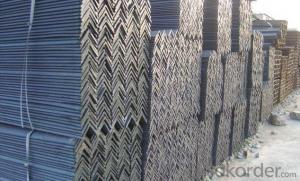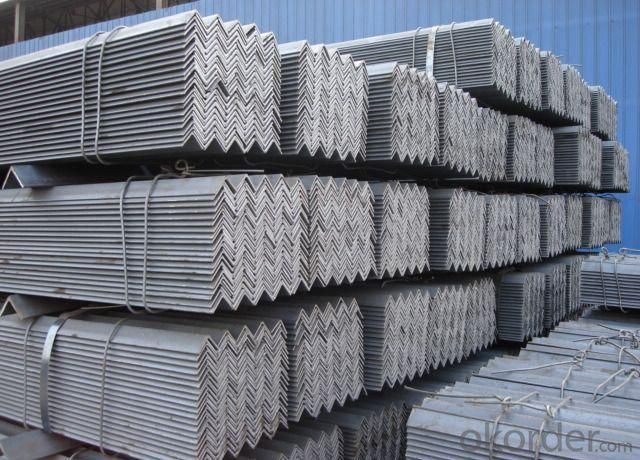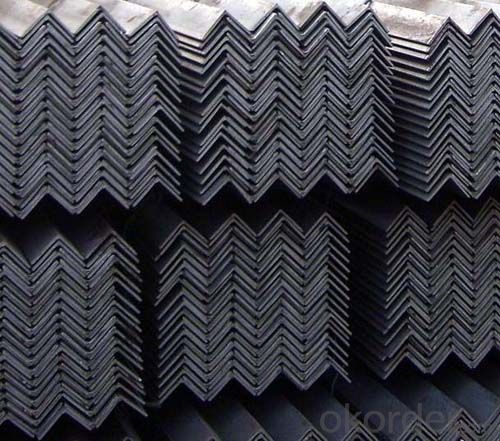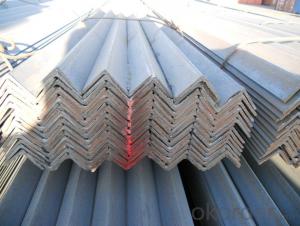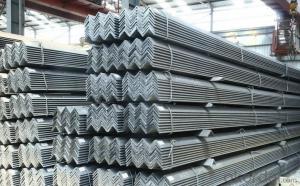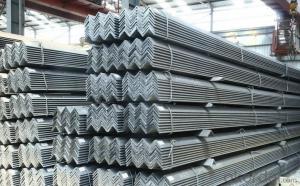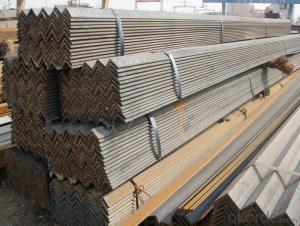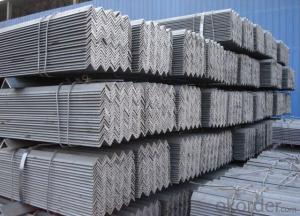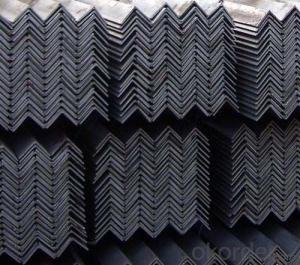Steel Equal Angle with Good Quality 100*100*6.0-12.0mm
- Loading Port:
- Tianjin
- Payment Terms:
- TT OR LC
- Min Order Qty:
- 50 m.t
- Supply Capability:
- 15000 m.t/month
OKorder Service Pledge
OKorder Financial Service
You Might Also Like
Specification
Product Description:
Specifications of Steel Equal Angle with Good Quality 100*100*6.0-12.0mm:
1. Invoicing on theoretical weight or actual weight as customer request
2. Length: 6m, 9m, 12m as following table
3. Sizes

| Size(mm) | Mass(Kg/m) | Size(mm) | Mass(Kg/m) |
| 100*100*6.0 | 9.366 | 100*100*10.0 | 15.12 |
| 100*100*7.0 | 10.83 | 100*100*12.0 | 17.898 |
| 100*100*8.0 | 12.276 |
Payment terms:
1).100% irrevocable L/C at sight.
2).30% T/T prepaid and the balance against the copy of B/L.
3).30% T/T prepaid and the balance against L/C
Material details:
Grade | Element (%) | ||||
C | Mn | S | P | Si | |
Q235 | 0.12—0.20 | 0.3—0.7 | ≤0.045 | ≤0.045 | ≤0.3 |
Usage & Applications of Steel Equal Angle with Good Quality 100*100*6.0-12.0mm:
According to the needs of different structures, Angle can compose to different force support component, and also can be the connections between components. It is widely used in various building structures and engineering structures such as roof beams, bridges, transmission towers, hoisting machinery and transport machinery, ships, industrial furnaces, reaction tower, container frame and warehouse etc.
Packaging & Delivery of Steel Equal Angle with Good Quality 100*100*6.0-12.0mm:
1. Packing: it is nude packed in bundles by steel wire rod
2. Bundle weight: not more than 3.5MT for bulk vessel; less than 3 MT for container load
3. Marks:
Color marking: There will be color marking on both end of the bundle for the cargo delivered by bulk vessel. That makes it easily to distinguish at the destination port.
Tag mark: there will be tag mark tied up on the bundles. The information usually including supplier logo and name, product name, made in China, shipping marks and other information request by the customer.
If loading by container the marking is not needed, but we will prepare it as customer request.
Production flow of Steel Equal Angle with Good Quality 100*100*6.0-12.0mm:
Material prepare (billet) —heat up—rough rolling—precision rolling—cooling—packing—storage and transportation
FAQ:
Q1: Why buy Materials & Equipment from OKorder.com?
A1: All products offered byOKorder.com are carefully selected from China's most reliable manufacturing enterprises. Through its ISO certifications, OKorder.com adheres to the highest standards and a commitment to supply chain safety and customer satisfaction.
Q2: How do we guarantee the quality of our products?
A2: We have established an advanced quality management system which conducts strict quality tests at every step, from raw materials to the final product. At the same time, we provide extensive follow-up service assurances as required.
Q3: How soon can we receive the product after purchase?
A3: Within three days of placing an order, we will begin production. The specific shipping date is dependent upon international and government factors, but is typically 1 to 2 months.
Q4: How many tons can be loaded into one 20ft container?
A4: Around 23—25tons
Images of Steel Equal Angle with Good Quality 100*100*6.0-12.0mm:
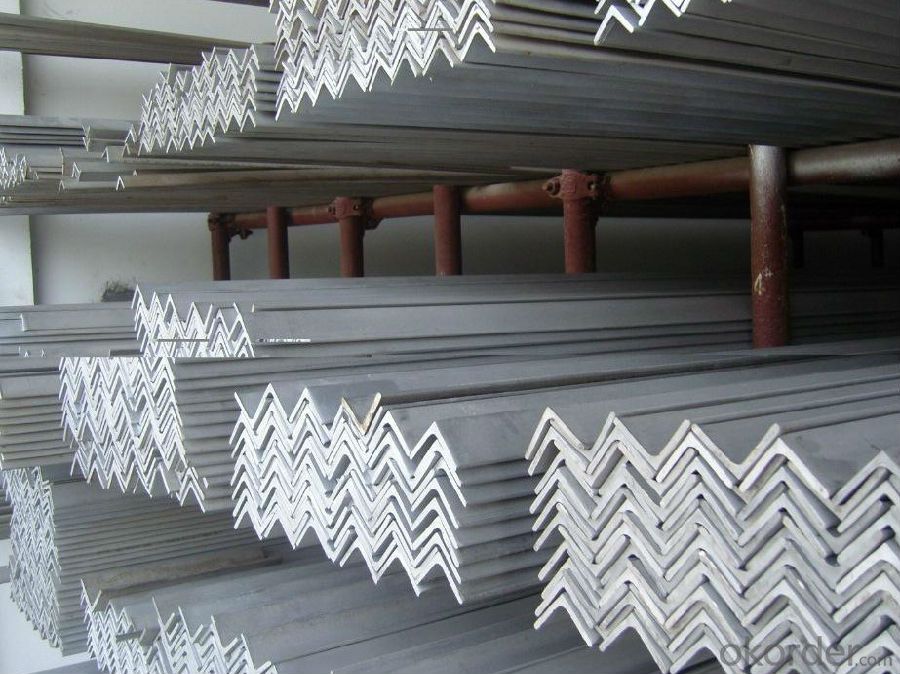

- Q: Can steel angles be used in telecommunications or broadcasting structures?
- Absolutely! Steel angles have a multitude of applications in the telecommunications and broadcasting industry. Their exceptional strength, durability, and versatility make them a staple in construction. From antenna mounts to equipment racks and cable trays, steel angles offer unparalleled structural support and stability. Moreover, their effortless fabrication and ability to be tailored to meet precise design specifications further solidify their suitability for a vast array of telecommunications and broadcasting needs.
- Q: Can steel angles be used in the construction of conveyor systems?
- Yes, steel angles can be used in the construction of conveyor systems. Steel angles are commonly used as structural support in conveyor systems to provide stability and strength to the framework. They can be easily welded or bolted together to create the desired configuration for the conveyor system, making them a versatile and reliable choice in construction.
- Q: What are the different types of steel angles used in scaffolding?
- There are several types of steel angles commonly used in scaffolding. These include: 1. Equal Angle: This type of steel angle has equal sides and is often used as a base or support in scaffolding structures. It provides stability and strength to the scaffolding system. 2. Unequal Angle: As the name suggests, this type of steel angle has unequal sides. It is used when there is a need for different lengths on each side, such as for creating diagonal bracing or for connecting different parts of the scaffolding system. 3. L-Shaped Angle: This steel angle has a 90-degree angle and is commonly used for creating corners or connecting two perpendicular scaffolding components. It offers structural support and stability to the scaffolding structure. 4. T-Shaped Angle: This type of steel angle has a T-shape and is used to connect two perpendicular scaffolding components. It provides stability and support to the scaffolding system. 5. Channel Angle: This steel angle has a U-shaped channel and is often used as a top or bottom cross member in scaffolding structures. Its design allows for easy attachment of scaffolding components and provides strength to the overall scaffolding system. These different types of steel angles offer versatility and strength to scaffolding structures, allowing for various configurations and designs based on the specific requirements of the project.
- Q: How are steel angles measured?
- Two main dimensions are used to measure steel angles: the length of each leg and the thickness of the material. Each leg's length refers to the distance from the intersection point of the two legs to the end of each leg. This measurement is typically expressed in inches or millimeters. The material's thickness, also known as the gauge, measures the width of the steel angle. It is commonly expressed in fractions of an inch or millimeters. To provide a comprehensive measurement, steel angles are often described by combining these two dimensions. For instance, a typical specification could be "2 x 2 x 1/4," indicating that the steel angle has legs measuring 2 inches in length, a thickness of 1/4 inch, and both legs are of equal length. It's worth noting that steel angles can be measured differently depending on the specific industry or region. Metric measurements may be used in some industries, while others may prefer imperial measurements. Therefore, it's always advisable to verify the measuring standards used in a particular context to ensure accurate understanding and communication.
- Q: Can steel angles be cold-formed or bent to specific shapes?
- Indeed, it is possible to cold-form or bend steel angles to attain particular shapes. Cold forming refers to the act of reshaping metal without the application of heat, usually accomplished through techniques such as bending, rolling, or pressing. Steel angles, which consist of L-shaped steel components, can undergo cold forming to achieve diverse shapes and angles in accordance with project specifications. This procedure entails exerting force and pressure on the steel angle, resulting in its deformation and acquisition of the desired form. By employing cold forming techniques on steel angles, one can achieve design flexibility and customization while preserving the strength and durability of the steel material.
- Q: What are the different standards and specifications for steel angles?
- There are several different standards and specifications for steel angles, including the American Society for Testing and Materials (ASTM) A36 and A572, the Society of Automotive Engineers (SAE) J429, and the European Union (EU) EN 10056. These standards outline the specific requirements for dimensions, chemical composition, mechanical properties, and tolerances of steel angles, ensuring consistency and quality in their production and use.
- Q: What is the process of punching holes in steel angles?
- The process of punching holes in steel angles typically involves using a specialized machine called a punch press. The steel angle is securely clamped into the machine, and then a punch and die set is aligned with the desired location for the hole. The machine is then activated, and the punch is driven into the steel angle, creating a hole. This process can be repeated multiple times to create multiple holes in the steel angle, if needed.
- Q: How do steel angles contribute to the overall earthquake resistance of a structure?
- Several ways contribute to the overall earthquake resistance of a structure by steel angles. Firstly, steel angles are commonly utilized as reinforcement elements in the construction industry. When installed and anchored properly, they can enhance the strength and stability of a structure, making it more resistant to the lateral forces generated during an earthquake. Moreover, steel angles are often employed in the creation of moment-resisting frames. These frames, composed of interconnected steel angles, are designed to absorb and distribute seismic energy throughout the structure. By distributing the seismic load, steel angles help prevent concentrated stress points and potential structural failures. Furthermore, steel angles can be strategically positioned at key locations, such as corners, junctions, and openings, to enhance the overall stiffness and rigidity of the structure. This increased stiffness assists in reducing the building's response to seismic vibrations and prevents excessive deformations that may lead to structural damage. Additionally, steel angles enable the creation of diagonal bracing systems, which are crucial for mitigating the effects of seismic forces. These systems consist of interconnected steel angles placed diagonally within the structure, forming a network that improves the building's ability to withstand lateral loads. Diagonal bracing effectively dissipates earthquake energy and redirects it away from critical components, thus enhancing the overall earthquake resistance of the structure. In conclusion, steel angles play a vital role in enhancing the earthquake resistance of a structure. They provide reinforcement, create moment-resisting frames, increase stiffness, and allow for the installation of diagonal bracing systems, all of which contribute to the structural integrity and resilience of a building during seismic events.
- Q: What are the different load-carrying capacities for steel angles?
- The load-carrying capacities of steel angles can vary due to different factors such as angle size, shape, steel type, and specific use. Typically, these capacities are determined by considering the maximum stress or load that an angle can bear without permanent deformation or failure. This is usually expressed as the maximum axial or bending load that the angle can support. To find the load-carrying capacity of a specific steel angle, engineers and structural designers refer to industry standards like the AISC Manual of Steel Construction. These standards provide tables and formulas that consider the angle's dimensions, thickness, and moment of inertia to calculate its load-carrying capacity. It's important to note that load-carrying capacities for steel angles are specified for specific loading conditions and safety factors. These factors include the type of load, direction and magnitude of the applied load, and the safety factor necessary for structural integrity and durability. Therefore, it's crucial to consult relevant codes, standards, and engineering resources to determine the specific load-carrying capacity of a steel angle for a particular application. Professional structural engineers and designers have the expertise and familiarity with design codes and standards to assess and determine these capacities accurately.
Send your message to us
Steel Equal Angle with Good Quality 100*100*6.0-12.0mm
- Loading Port:
- Tianjin
- Payment Terms:
- TT OR LC
- Min Order Qty:
- 50 m.t
- Supply Capability:
- 15000 m.t/month
OKorder Service Pledge
OKorder Financial Service
Similar products
Hot products
Hot Searches
Related keywords
